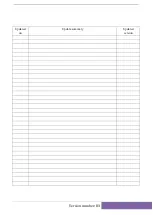
© ElectroCraft 2018
35
CPP-A12V80A-SA-USB Technical Reference
12.3 Selecting External Brake Resistor
For properly sizing the resistor, a complex calculation requiring detailed information about the application
and load is needed. This data is often not known or difficult to obtain, so ElectroCraft has provided the
following guideline as a starting point which has proven sufficient in the majority of applications. If further
support is needed or this recommendation does not provide the required performance please contact
ElectroCraft.
12.3.1 Calculating resistance value of the braking resistor
The resistance value of the braking resistor and the power supply voltage will determine the rate at which
energy is dissipated in it. The minimum resistance can be calculated from the following equation.
Minimum Resistance value
=
𝑆𝑆𝑆𝑆𝑆𝑆𝑆𝑆𝑆𝑆𝑆𝑆
𝑉𝑉𝑉𝑉𝑆𝑆𝑉𝑉𝑉𝑉𝑉𝑉𝑉𝑉
𝑀𝑀𝑉𝑉𝑀𝑀𝑀𝑀𝑀𝑀𝑆𝑆𝑀𝑀
𝑑𝑑𝑉𝑉𝑑𝑑𝑉𝑉𝑆𝑆𝑉𝑉𝑑𝑑𝑉𝑉𝑉𝑉𝑀𝑀𝑉𝑉𝑑𝑑
𝑑𝑑𝑆𝑆𝑑𝑑𝑑𝑑𝑉𝑉𝑑𝑑𝑉𝑉
𝑉𝑉𝑜𝑜
𝑉𝑉ℎ𝑉𝑉
𝑀𝑀𝑉𝑉𝑉𝑉𝑉𝑉𝑑𝑑
The next nearest resistor higher than the calculated value should be selected.
The table below gives the minimum resistance values for standard power supply voltages at drive
continuous current of 12A. Use the equation above to calculate the maximum resistance value for other
supply voltage and drive continuous current/deceleration current.
Deceleration Current
(A)
Power Supply Voltage
(Vdc)
Minimum Resistance value
(Ω)
12
12
1
24
2
48
4
60
5
80
6.66
The resistance value for appropriate power supply voltage (when brake resistor On and Off voltages are
set according to section 12.3.2) in the above table is a good starting point. Increase the resistance value
for lower deceleration current.
Drive faults due to Shunt Overpower or Bus Overvoltage (refer section 13 for drive fault codes) indicates
that the resistor is not dissipating enough power. A lower value resistor or lower deceleration current may
be required.







































